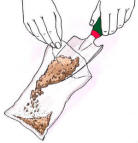No Cooperative
Extension
Service
Educator/Agent worth his or her salt can ever present an
educational program without recommending that you take a
soil test. Some people think this is just because the
agency makes a profit on each one they sell. However,
the truth is that, until you know your current soil
status, you are just wandering around in the dark in
terms of what to do next.
Taking A Soil Sample - Any time that the soil is not frozen
is a good time to have the soil from gardens, lawns,
flowerbeds or fields tested. A standard soil test will tell
you the level of major nutrients such as
phosphorus and
potassium, the
pH,
soil type, and the
nutrient holding
capacity of the soil. Based on these levels, a
computer-generated recommendation will tell you how much
fertilizer is needed to grow a good crop of
vegetables, grass
or flowers.
The key factor in taking a soil sample is that it must
REPRESENTATIVE of the area you are testing. If you go
out and dig one hole and make your sample exclusively of
soil from it, you might be in trouble. That may be the
absolutely best or worst spot in your landscape. This
would lead to faulty results that could lead to the
application of too much or too little in terms of
nutrients or
pH balancing.
 So, the best thing to do is to take
several small subsamples at many (6 to 10) places around
your planting area. Then, thoroughly mix all the
subsamples together in a clean plastic pail or bag
before you scoop out enough for the sample size needed
by the lab. This should give you a good average sampling
that will be representative of the entire area.
So, the best thing to do is to take
several small subsamples at many (6 to 10) places around
your planting area. Then, thoroughly mix all the
subsamples together in a clean plastic pail or bag
before you scoop out enough for the sample size needed
by the lab. This should give you a good average sampling
that will be representative of the entire area.
Another part of being "representative" is to take the
sample down to the typical depth of the root systems of
the plants you will be growing. For most perennials,
this would be around 6 to 10 inches while trees might go
a little deeper to about 18 inches. Turfgrass needs to
go down to about 6 inches in depth for a sample.
How many samples should you take? Generally, a "sample"
will be determined by two factors. One is the crop to be
grown. So, if you have perennial beds and borders (or
mixed beds or borders), lawn and a small orchard area,
you might benefit from 3 different samples. Be sure to
label each sample based on its location so that the
different recommendations will be easier to apply
properly.
The second factor is the type of soil. If you have a
high ground area that is very sandy and a lower area
that is generally more of a
clay type soil, this would
call for 2 different samples. Nutrient and pH change
recommendations will vary depending on the soil type
being tested.
Submitting the Soil Sample - When choosing a laboratory to test your
soil sample, you have basically three options.
A. Do It Yourself - There are all kinds of soil test kits
out there on the market. Perhaps the best thing to say
about them is that you get what you pay for when you
purchase one. You might be able to get an accurate
result from the kits and you might not. You will never
really know. If you do everything exactly according to
the directions, you will get a good, general idea about
soil pH or soil nutrient levels but that is about all.
Most of the time, I suspect people get widely varying
results and they don't know enough about soil chemistry
to figure that out. As you can tell, I am not a big fan
of the home test kits.
B. Private Soil Laboratory - There are private companies that offer
soil testing services. These are generally run by people
trained in soil chemistry who can take your sample and
turn it into reliable recommendations. Often, you can
find such companies by doing an internet search.
 C.
University Laboratory - Every state has at least one Land Grant
University which will have an
Extension
Service office in all
(or nearly all) counties of the state. These will offer
a service where you bring your sample to the office or
mail it directly to the university for analysis. This is
probably the option used by most home gardeners.
C.
University Laboratory - Every state has at least one Land Grant
University which will have an
Extension
Service office in all
(or nearly all) counties of the state. These will offer
a service where you bring your sample to the office or
mail it directly to the university for analysis. This is
probably the option used by most home gardeners.
Related Articles: Soil pH
- Acid Soils -
Alkaline Soils - Lime -
Soil Test



